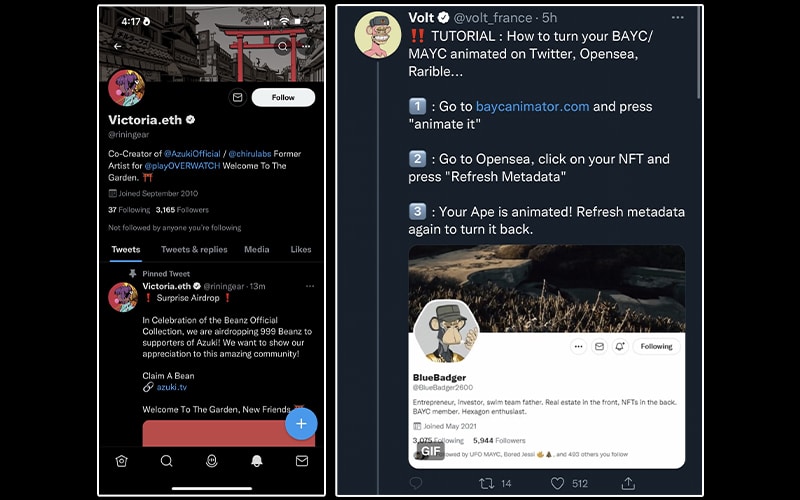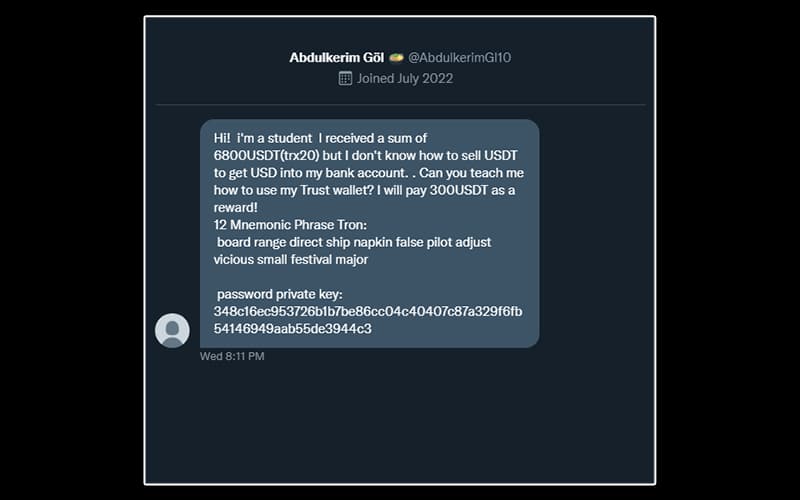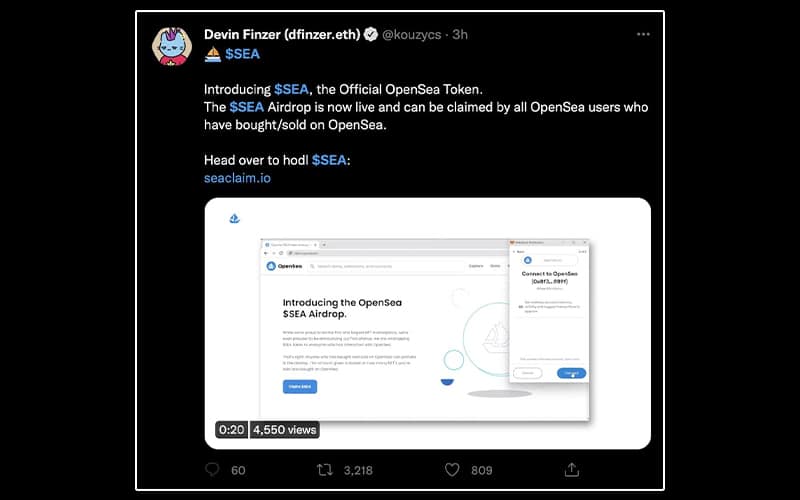Unlike other financial systems, there are also bad actors present in the DeFi space. Since the inception of DeFi, Crypto and NFT holders have often witnessed bizarre scams, cyberattacks, or exploitation of protocols that drain billions of users’ funds along with the savings.
Here are the 7 most severe types of crypto scams on Twitter that the DeFi world has experienced and you should be aware of them.
1. Mimicking Websites and Projects Through Unicode Letters
As the name suggests, perpetrators deceive people by spoofing URLs through Unicode letters, which seem similar to original letters. This link directs you to fake websites, which again, looks like the original ones. These kinds of Twitter crypto scams generally target newbies or those hodling up a small amount of crypto and wanting to multiply instantly.
There are different tools and websites on the internet, where anyone can generate fake URLs by replicating original letters with Unicode letters. However, sometimes these Unicode letter URLs mostly come up with another hyperlink to hide specific domain names.
Some Unicode letter examples are given below. Here note this, these examples are just for educational purposes.
| Original | Spoof URLs |
| https://www.cryptoblogs.io/ | :// . ï . / |
| https://opensea.io/ | :// ʂ . / |
2. Scams through Verified Profile on Twitter
In our list, the next popular Twitter crypto scam is the scam from verified profiles.
As human beings, people always trust big names and authority from particular fields. Crypto and NFT space is not exceptional for this. Usually, Crypto aficionados and NFT enthusiasts follow big profiles and verified accounts of crypto and NFT projects on Twitter.
Nowadays it’s become a very common step to make any important announcement regarding project updates on social media profiles such as Discord server, Twitter, or elsewhere.

Twitter has an algorithm which verifies the account with blue ticks after checking its authenticity. So people easily count on these accounts and follow announcements to secure their digital assets like cryptocurrencies, stablecoins, and NFTs.
But what if these verified accounts got hacked and it’s fully under the control of black hats? Yes, hackers are skilled enough to execute phishing scams after getting control of these “blue ticked” verified accounts.
Hackers leverage verified accounts to create panic and fear in people about their crypto and NFTs by making false announcements about possible attacks. Mostly, these announcements direct people towards phishing scam websites, which asks them to sign transactions linked to the transfer of all their funds and NFTs to other addresses.
This kind of Twitter crypto scam performed mostly involves these steps-
- Sparks fears in crypto and NFT holders through false announcements about possible threats of hack, exploitation, or scams.
- Uses botted accounts to promote their posts on Twitter through likes, retweets, mass DMs or mentioning others.
- The Link attached in the announcements directs people toward the phishing scam website.
- The website tricks users to sign transactions that allow a hacker to drain away their crypto and NFTs.
3. Honeypot Account
If you are holding up any tokens into your digital wallet and active trading, you might have received some DMs on your social media on a regular basis. Most of these DMs are ignored by people because of their irrelevancy. Unfortunately, there are still some people who fall into such traps. These Twitter crypto scams mostly target individuals.
Although the majority of these accounts already have some tokens, senders nonetheless compel recipients to aid in money withdrawals. The majority of these fraudulent addresses won’t be capable of even covering transaction costs.

This is where the game begins. In order to cover transaction fees and receive rewards from the sender, users typically add some money. But as soon as money is sent to a fraudulent address, it is automatically transferred back to the scammer’s wallet.
4. Fake Airdrop Announcements
Forthcoming Twitter crypto scam is false Airdrop announcements that drains millions of dollars of crypto funds from the crypto space.
On a daily basis, there are hundreds or thousands of fake airdrops of some random tokens appearing on Twitter or any other social media accounts. But, this airdrop becomes more dangerous when it is announced from some reputed and verified profiles.

As we mentioned earlier, hackers can compromise and leverage verified accounts to complete their wrong intentions. Airdrops are beloved by the black hat hacker after compromising some famous profiles.
They entice some specific NFT holders such as Bored Ape Yacht Club, Azuki, MAYC, or others by promising to give away some newly generated tokens.
Once these NFT holders press their cursor on click beats, they unknowingly make the process to sign malicious transactions and approve the transfer of their funds and NFTs to the hacker’s wallet.
5. Scams Through Play-to-earn games
There is no room for doubt that P2E gaming projects are going to hold a big piece of the cake in decentralization. GameFi space is still in its infancy and has big potential to grow in the next 5-10 years.
These fascinating GameFi concepts also become another great opportunity for Twitter crypto scammers.

However, on the dark side of GameFi, there are many P2E gaming projects taking shape that can spoil users’ experience in this nascent decentralized space. These games mostly contain malware hidden in their files. This malware is being designed to steal users’ browser and extension data.
6. Fake Art Commissions
Twitter Crypto scam targets digital artists and influencers involved in digital artworks by commissioning fake work for illegitimate companies. The work file provided by the fake company fills up with malware or an extension spoofed Screen saver (.scr) file which is an executable file.
These files can steal targeted artists’ crucial data such as cookies, passwords, extension data, wallet data and more. Thus, putting the future of the artist in jeopardy.
7. Front Running Scams
If you are on Twitter, you might have noticed and promoted notifications about being mentioned in random posts. This post features some enticing clauses like “make $1400/DAY front-running Uniswap” to force you to click on their given links and watch the video. This is nothing else but another Twitter crypto scam model.
The video contains wrong information related to how the start() and withdrawal() functions work. Once you call one of these functions to make money, it will transfer all your funds into another contract created by the perpetrator, and ultimately your fund will end up in its addresses.
Also Read: The 10 Most Common NFT Scams and Techniques to Avoid Them
How to Avoid Crypto Scams on Twitter?
- Avoid unusual interaction with dubious emails, DMs, or Tweets.
- Do not trust any click beats or URLs attached with tweets that direct you to scam websites.
- If you are not aware of programming or functions in smart contracts, then kindly avoid the instructions given by the anonymous as there are high chances that you will end up with zero balance in your crypto wallet.
- Don’t share your private keys with anyone.
- Don’t send your crypto to unknown addresses to “double” it. Even if some verified profiles on Twitter ask you to do the same, don’t trust it. It could potentially be a hacker behind that account.
Conclusion:
Apart from this, Hackers know the desperation of people who are being scammed or have recently fallen prey to an attack to recover lost funds. By promising to recover their lost funds, the attackers collect fees in the name of deployment of smart contracts on the blockchain and then flee away with it.
With the expansion of defi space, Twitter crypto scams are also fostering because of a lack of data security in place. While surfing on the internet and social media like Twitter, we should be aware of opportunists out there who are waiting for your one wrong move.
Here we have also mentioned some tips to prevent yourself from falling prey to any kind of Twitter crypto scams.







